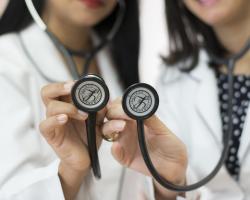The Silesian Centre for Heart Diseases in Zabrze is one of the leading highly specialised institutions in the country engaged in the diagnostics and treatment of heart, vascular and pulmonary diseases in adults and children.
The first heart transplant in Poland was conducted here (1985), cardiomyoplasty (1997), simultaneous heart and lungs transplant (2001), and a successful lung transplant in a patient with mucoviscidosis (2011). The biggest surgical reperfusion programme for acute coronary attacks in Poland so far and a life-saving ECMO system were introduced.
SCHD also runs the biggest nationwide lung and heart transplant programme. So far, approximately one thousand heart transplants and about a hundred lung transplants have been conducted here.
Adult and child heart surgeries
Every year, the hospital admits approximately 15 thousand patients. Yearly the doctors conduct over 12 thousand invasive cardiac procedures and over 2.4 thousand heart surgeries in adults and children, many using minimally invasive techniques.
“The cardiac surgery unit in Zabrze carried out over 34 thousand heart surgeries on children and adults in the years 1985-2013. Currently, there is no type of heart surgery in the world which cannot be conducted in our centre," says the Director of the hospital and the national consultant in the field of cardiac surgery, Professor Marian Zembala.
The hospital in Zabrze also introduced one of the biggest programmes of mechanical circulatory support in adults and children using extracorporeal pumps. They allow the patient to see the transplant or allow their heart to recover.
Professor Zembala sees the development of the programme to save patients with the use of new generation completely implantable axial flow pumps, imported from the United States, as a great success.
After 2-3 weeks of hospitalisation, the patients can go home, where – monitored by the SCHD team – they wait for their heart to recover or for the transplant.
Treatment and education at the Centre
The hospital complex consists of a modernised building – Pavillon A – and the modern Pavillon B, commissioned in April 2011. The respective departments deal with heart failure, minimally invasive cardiac surgery, and also vascular and endovascular surgery. There is also a complex of specialist outpatient clinics. Nearly 52 thousand consultations are conducted there every year.
Building B was constructed and equipped thanks to the hospital’s savings, EU funds and the programmes provided by the Minister of Health and the Marshal of the Silesian Voivodeship. The new building incorporates, among others, a hybrid operating room, the first opened in Poland, where cardiac surgeons, invasive cardiologists and anaesthesiologists work together. This is a combination of an extensive and highly modernised operating room with well-equipped hemodynamic operating room.
In 2012, thanks to EU funding, another investment was commenced: the construction of the Polish clinical and scientific centre of lung and heart transplants and mucoviscidosis treatment in adults and children – the so-called Pavillon C.
SCHD is also an academic institution, connected with the Silesian Medical University, educating students of medicine, medical rescue and nursing, and specialising doctors. In 2006 a Centre for Science, Training and New Technologies was created, where young doctors and students are trained with the use of phantoms and biostimulators.
The centre was established in 1984, on the initiative of Professor Stanisław Pasyk – the then Director of SCHD, Professor Zbigniew Religa – the creator of the clinic and the cardiac surgery school in Silesia, and Dr Lillia Goldstein – the pioneer of children’s cardiology in Poland.





-250x200.jpg)



Comments (0)